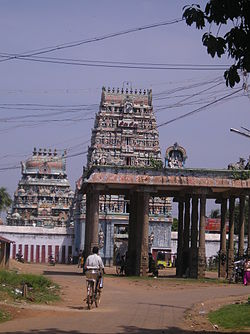Masilamaniswara Temple, Thirumullaivoyal
| Masilamaniswara Temple | |
|---|---|
 | |
| Religion | |
| Affiliation | Hinduism |
| District | Tiruvallur |
| Deity | Masilamaninathar(Shiva) Kodiyidai Nayagi(Parvati) |
| Features |
|
| Location | |
| Location | Thirumullaivoyal |
| State | Tamil Nadu |
| Country | India |
Location in Tamil Nadu | |
| Geographic coordinates | 13°08′11″N 80°07′57″E / 13.136417°N 80.132400°E |
| Architecture | |
| Type | Dravidian architecture |
| Completed | 9th century CE |
The Masilamaniswara Temple, Thirumullaivoyal or Masilamaniswara Temple is a
The temple is believed to have been built by
The temple is one of the Sakthi triad in the region of
Legend




In ancient times, the forest surrounding
History
The temple has inscriptions from the period of
Architecture

The vimana (roof) of the sanctum sanctorum is designed in a special way that is exclusive to
Religious importance
Thirumullaivoyal is one of the many temple towns in the state which is named after the grooves, clusters or forests dominated by a particular variety of a tree or shrub and the same variety of tree or shrub sheltering the presiding deity. The region is believed to have been covered with Chamapaka forest and hence called Chamapakavanam.[7] She and Her counterparts, Tiruvudai Amman Thirumanangeeswarar Temple- She who symbolises Lakshmi and Vadivudai Amman Thyagaraja Temple, Tiruvottiyur- She who is resplendent with her gracious beauty, are believed to be three Goddesses who shower all auspicious things in life if visited and worshipped on the same day of Chitra Pournami - the full moon day in the Tamil month of Chithirai.
Sundarar, an 8th-century Tamil Shaiva poet, venerated Masilamaniswarar in ten verses in Tevaram, compiled as the Seventh Tirumurai. As the temple is revered in Tevaram, it is classified as Paadal Petra Sthalam, one of the 275 temples that find mention in the Shaiva canon. The temple is counted as the 52nd in the list of temples in the northern banks of Cauvery.[8]
The temple with Kodiyidai Amman as its chief goddess is the third of the Sakthi temple triad in the region of the Tondaimandalam, namely, Thiruvudai Amman (also known as Ichchaa Sakthi, the goddess who fulfills devotees' wishes), Vadivudai Amman (also known as Gnaana Shakti, the goddess who blesses with gnana or knowledge), and Kodiyidai Ammam (also known as Kriya Shakti, the goddess who assists in all actions). The Vadivudai Amman shrine or Thyagaraja Temple is at Tiruvottiyur while the Thiruvudai Amman shrine or Thirumanangeeswarar Temple is at Minjur.[6]
Worship practices

The temple priests perform the
See also
External links
References
- ^ Iyengar, P. T. Srinivasa. History of the Tamils: from the earliest times to 600 A.D. p. 26.
- ^ a b c d "Sri Othandeeswarar temple". Dinamalar. 2014. Retrieved 31 May 2014.
- ISBN 9788183794688.
- ^ S.R., Balasubramanyam (1975). Early Chola temples Parantaka I to Rajaraja I (AD. 907-985) (PDF). Thomson Press (India) Limited. pp. 209–14.
- ISBN 9789350093917.
- ^ a b R., Dr. Vijayalakshmy (2001). An introduction to religion and Philosophy - Tévarám and Tivviyappirapantam (1st ed.). Chennai: International Institute of Tamil Studies. pp. 386–7.
- ISBN 978-81-7823-542-4.
- ^ Swamigal, Tirunavukkarasu. "Tevaram Of Tirunavukkaracu Cuvamikal Tirumurai 5 part - 2 Poems(510-516)" (PDF). projectmadurai.org. pp. 33–34. Retrieved 13 December 2011.

